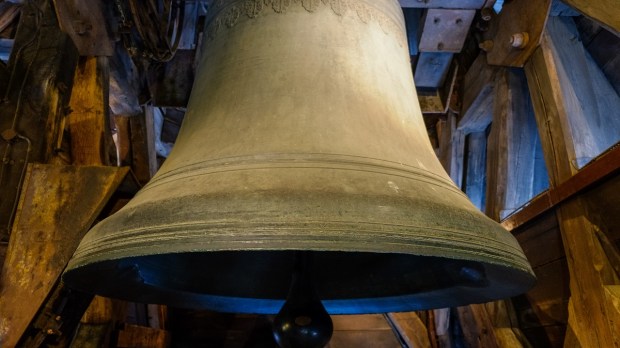Lenten Campaign 2025
This content is free of charge, as are all our articles.
Support us with a donation that is tax-deductible and enable us to continue to reach millions of readers.
As Notre Dame de Paris continues to be restored, on track for its late 2024 reopening, the faithful have taken to sharing images of the iconic French cathedral’s bells in anticipation of hearing them ring through France’s capital once more. The image, which was taken years ago, shows nine of their bells arranged in size order, with the largest dwarfing the men in procession.
Many may not know, however, that each bell bears a name and also inscriptions that relate to the monikers. Some of them allude to saints and biblical figures, while others pay homage to influential Catholics of France, but each one is a unique piece of French cultural history that will be replaced in the monument church after cleaning and restoration.
The largest bell, pictured front and center, is named “Emmanuel.” It is easy to notice that this bell looks a bit older and less shiny than the rest. This is because it is the only of Notre Dame’s bells to have survived the French Revolution. It is unclear whether it was left alone due to a respect for the faith or if the revolutionaries simply could not prize the 13-ton cast iron bell off the belfry. It stands as a valued piece of French cultural history.
Behind “Emmanuel” is “Marie,” the second largest bell, named for the Blessed Mother. This bell is a replica of the very one that was used from 1378 to 1792, when French revolutionaries removed it from Notre Dame. “Marie” is inscribed with the “Hail Mary” prayer, in French, which sits alongside an image of the Mother and Child, surrounded by stars. This bell weighs in at 13,278lbs or about 6.6 tons.
Next in the lineup is “Gabriel,” so named for the Archangel who announced the coming of both John the Baptist and Jesus Christ. This bell is engraved with the first line of the Angelus, as well as 40 circular lines. These represent both the 40 days Christ spent in the desert prior to his public ministry and the 40 years taken by Moses and the Israelites to cross Sinai. “Gabriel” weighs in at 9,175lbs or around 4.5 tons.
“Anne Genevieve” is the next in line, dually named for St. Anne, mother of the Blessed Virgin, as well as St. Genevieve, patron saint of Paris. This bell bears the second line of the Angelus and three circular lines that represent the Holy Trinity as well as the three theological virtues: Faith, Hope, and Charity. “Anne Genevieve” weighs about 7,665lbs, which is about 3.8 tons.
The next bell is “Denis,” so named for St. Denis, first Bishop of Paris and Catholic martyr of the 3rd century. According to legend, after being beheaded by the Romans for converting Pagans to Christianity, St. Denis picked up his head and walked for several miles, preaching a sermon the whole way. At the site where he supposedly collapsed and finally died, a small shrine was erected, which was eventually developed into the Basilica of St. Denis. “Denis” bears an inscription of the third line of the Angelus, and weighs an estimated 5,515lbs, or 2.7 tons.
Bearing the fourth line of the Angelus is “Marcel,” named for St. Marcel, the ninth Bishop of Paris. St. Marcel was a very influential figure to the Parisian people, who worked extensively with the city’s sick and poor in the 5th century. This bell bears five bands, which represent the Holy Trinity and the two natures of Christ forming the one God incarnate. It weighs 4,243lbs or 2.1 tons.
Next in line is “Étienne,” which recalls the previous iteration of the Parisian cathedral, which was named for St. Stephen (“Étienne” in French). St. Stephen is honored in the Catholic faith as the first martyr. As recorded in the Acts of the Apostles, St. Stephen was a first-century deacon who was stoned to death for blasphemy against the Jewish faith. This bell bears the fifth line of the Angelus, and weighs in at 3,293lbs or 1.6 tons.
Up next is the most recently named bell on the list, “Benoit-Joseph,” which pays tribute to Pope Benedict XVI, under his birth name Joseph Ratzinger. Along with the sixth line of the Angelus, this bell bears 12 circular lines representing the Apostles of Christ. This bell weighs 2,885lbs or 1.4 tons.
Near the back of the line is “Maurice,” named for Maurice de Sully, Bishop of Paris from 1160 until his retirement in 1196. De Sully was the prelate responsible for initiating the construction of Notre Dame de Paris. It bears the seventh line of the Angelus, “Pray for us, Holy Mother of God,” and weighs in at 2,228lbs or 1.1 tons.
Finally, the last and smallest of Notre Dame’s Bells is “Jean Marie,” so named for Cardinal Jean-Marie Lustiger. Cardinal Lustiger was another contemporary name to be honored by the Notre Dame bells, as he was the Bishop of Paris from 1981 to 2005. This bell bears the eighth and final line of the Angelus, with nine bands around it symbolizing the angelic hierarchy, as well as the initials and symbols of the four Evangelists within the bell. “Jean Marie” weighs 1,724lbs or .8 tons.
It may still be over a year before we hear Notre Dame’s bells ring over Paris once more, but until then, we can content ourselves with past recordings. To hear how it sounds when all the bells are ringing together, take a look at the video below.



